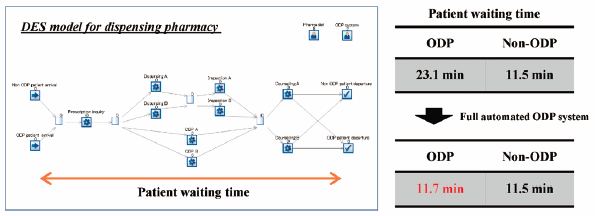- 著者
- Daisuke Furushima Hiroshi Yamada Michiko Kido Yuko Ohno
- 出版者
- The Pharmaceutical Society of Japan
- 雑誌
- Biological and Pharmaceutical Bulletin (ISSN:09186158)
- 巻号頁・発行日
- vol.41, no.3, pp.409-418, 2018-03-01 (Released:2018-03-01)
- 参考文献数
- 40
- 被引用文献数
- 2
Improvement in patient waiting time in dispensing pharmacies is an important element for patient and pharmacists. The One-Dose Package (ODP) of medicines was implemented in Japan to support medicine adherence among elderly patients; however, it also contributed to increase in patient waiting times. Given the projected increase in ODP patients in the near future owing to rapid population aging, development of improved strategies is a key imperative. We conducted a cross-sectional survey at a single dispensing pharmacy to clarify the impact of ODP on patient waiting time. Further, we propose an improvement strategy developed with use of a discrete event simulation (DES) model. A total of 673 patients received pharmacy services during the study period. A two-fold difference in mean waiting time was observed between ODP and non-ODP patients (22.6 and 11.2 min, respectively). The DES model was constructed with input parameters estimated from observed data. Introduction of fully automated ODP (A-ODP) system was projected to reduce the waiting time for ODP patient by 0.5 times (from 23.1 to 11.5 min). Furthermore, assuming that 40% of non-ODP patients would transfer to ODP, the waiting time was predicted to increase to 56.8 min; however, introduction of the A-ODP system decreased the waiting time to 20.4 min. Our findings indicate that ODP is one of the elements that increases the waiting time and that it might become longer in the future. Introduction of the A-ODP system may be an effective strategy to improve waiting time.
2 0 0 0 OA ドル・プレイの発達・臨床的効果を探る(1)
- 著者
- 大野 雄子 Yuko Ohno
- 出版者
- 千葉敬愛短期大学
- 雑誌
- 千葉敬愛短期大学紀要 = BULLETIN OF CHIBA KEIAI JUNIOR COLLEGE (ISSN:03894584)
- 巻号頁・発行日
- no.37, pp.11-17, 2015-03
- 著者
- Tianyi WANG Shima OKADA Masayuki ENDO Masaaki MAKIKAWA Yuko OHNO
- 出版者
- Japanese Society for Medical and Biological Engineering
- 雑誌
- Advanced Biomedical Engineering (ISSN:21875219)
- 巻号頁・発行日
- vol.10, pp.11-17, 2021 (Released:2021-01-26)
- 参考文献数
- 34
- 被引用文献数
- 3 4
Hiesho is the condition of having a cold sensation in one's hands or feet. This is a well-known health problem for young Asian females. However, the definition of Hiesho is still controversial. In this study, we aimed to develop a quantitative and non-invasive approach to determine Hiesho. Sixty-three young females participated in this research. Temperature difference (ΔT) between the forehead and foot sole was utilized to define Hiesho or non-Hiesho condition, and the result was crosschecked with that of a self-reported questionnaire. Central systolic blood pressure and augmentation index were measured to evaluate subjects' physiological indicators. The results of the questionnaire showed that 49% of young females (31 of 63 people) reported Hiesho. There was a significant difference in ΔT between non-Hiesho and Hiesho (1.85℃ and 5.55℃, respectively, p < 0.01). After cross-checking with the self-reported questionnaire, ΔT of 3.64℃ demonstrated acceptable reliability and accuracy for defining Hiesho. Central systolic blood pressure and augmentation index were not different between Hiesho and non-Hiesho. In conclusion, young females with Hiesho had drastically different temperatures at the forehead and foot sole. The temperature difference between the forehead and foot could be used as a quantitative and objective parameter for defining Hiesho.
- 著者
- Yukari Taniyama Takahiro Tabuchi Yuko Ohno Toshitaka Morishima Sumiyo Okawa Shihoko Koyama Isao Miyashiro
- 出版者
- Japan Epidemiological Association
- 雑誌
- Journal of Epidemiology (ISSN:09175040)
- 巻号頁・発行日
- pp.JE20190242, (Released:2020-01-11)
- 参考文献数
- 30
- 被引用文献数
- 6
Background: The impact of hospital surgical volume on long-term mortality has not been well assessed in Japan, especially for esophageal, biliary tract, and pancreatic cancer, although these three cancers need a high-level of medical technical skill. The purpose of this study was to examine associations between hospital surgical volume and 3-year mortality for these severe prognosis cancer patients.Methods: Patients who received curative surgery for esophageal, biliary tract, and pancreatic cancers were analyzed using Osaka Cancer Registry data from 2006-2013. Hospital surgical volume was categorized into tertiles (high/middle/low) according to the average annual number of curative surgeries per hospital for each cancer. Three-year survivals were calculated using the Kaplan-Meier method. Hazard ratios (HRs) of 3-year mortality were calculated using Cox proportional hazard models, adjusting for patient characteristics.Results: Three-year survival was higher with increased hospital surgical volume for all three cancers, but the relative importance of volume varied across sites. After adjustment for all confounding factors, HRs (95% Confidence interval [CI]) in middle- and low-volume hospitals were 1.34 (95% CI, 1.14-1.58) and 1.57 (95% CI, 1.33-1.86) for esophageal cancer; 1.39 (95% CI, 1.15-1.67) and 1.57 (95% CI, 1.30-1.89) for biliary tract cancer; 1.38 (95% CI, 1.16-1.63) and 1.90 (1.60-2.25) for pancreatic cancer, respectively. In particular localized pancreatic cancer, the impact of hospital surgical volume on 3-year mortality was strong (HRs: 2.66 [95% CI, 1.61-4.38]).Conclusion: We suggest that patients who require curative surgery for esophageal, biliary tract, and pancreatic cancer may benefit from referral to high-volume hospitals.
